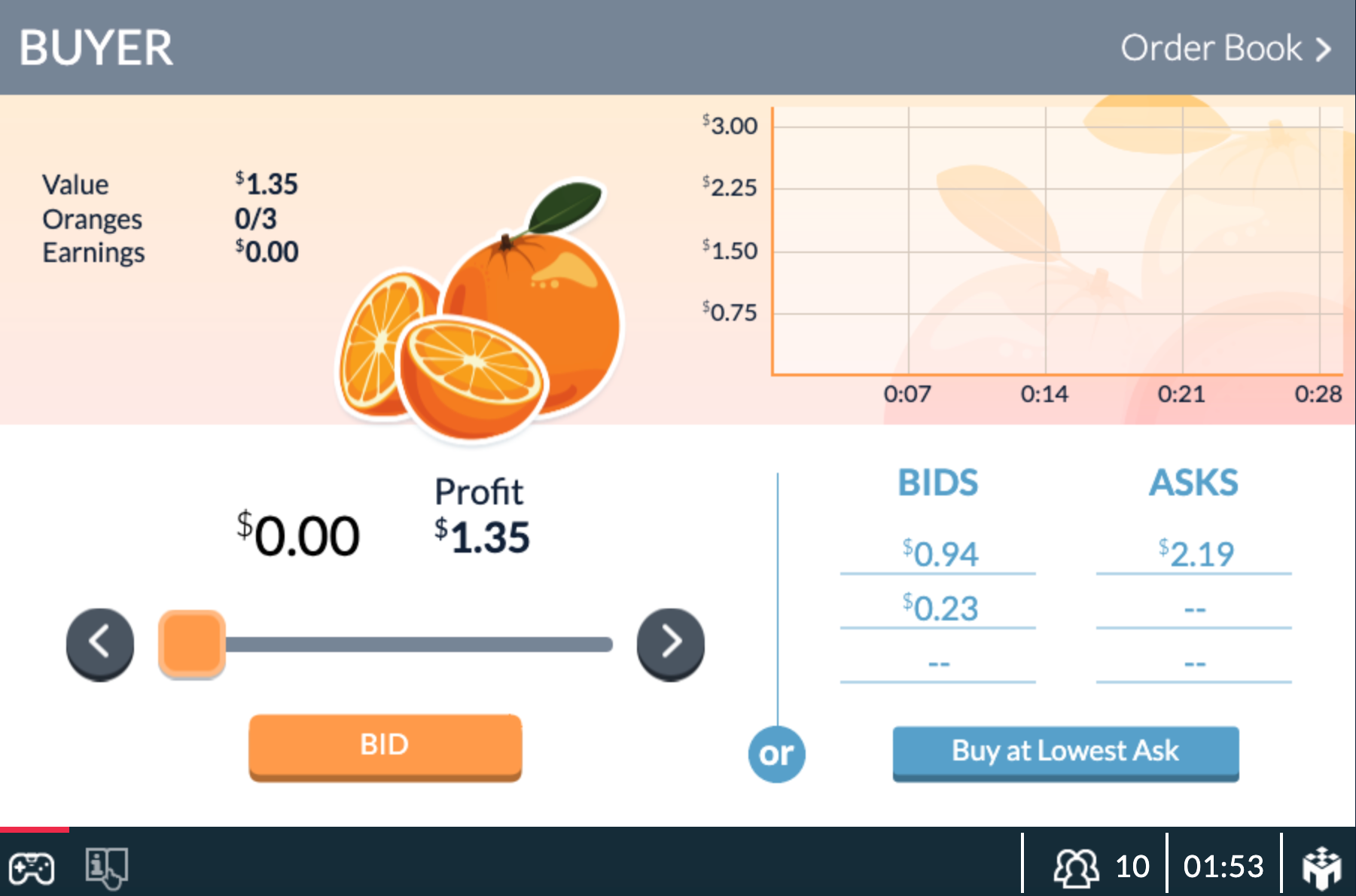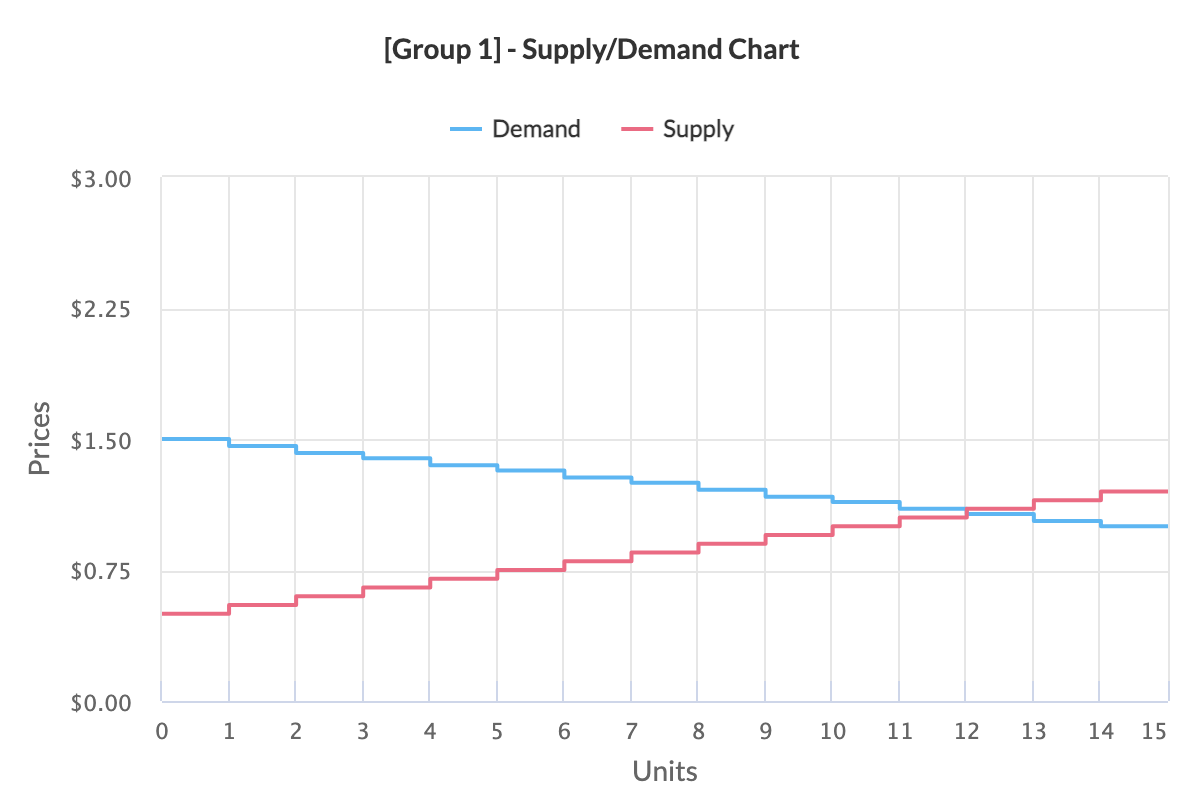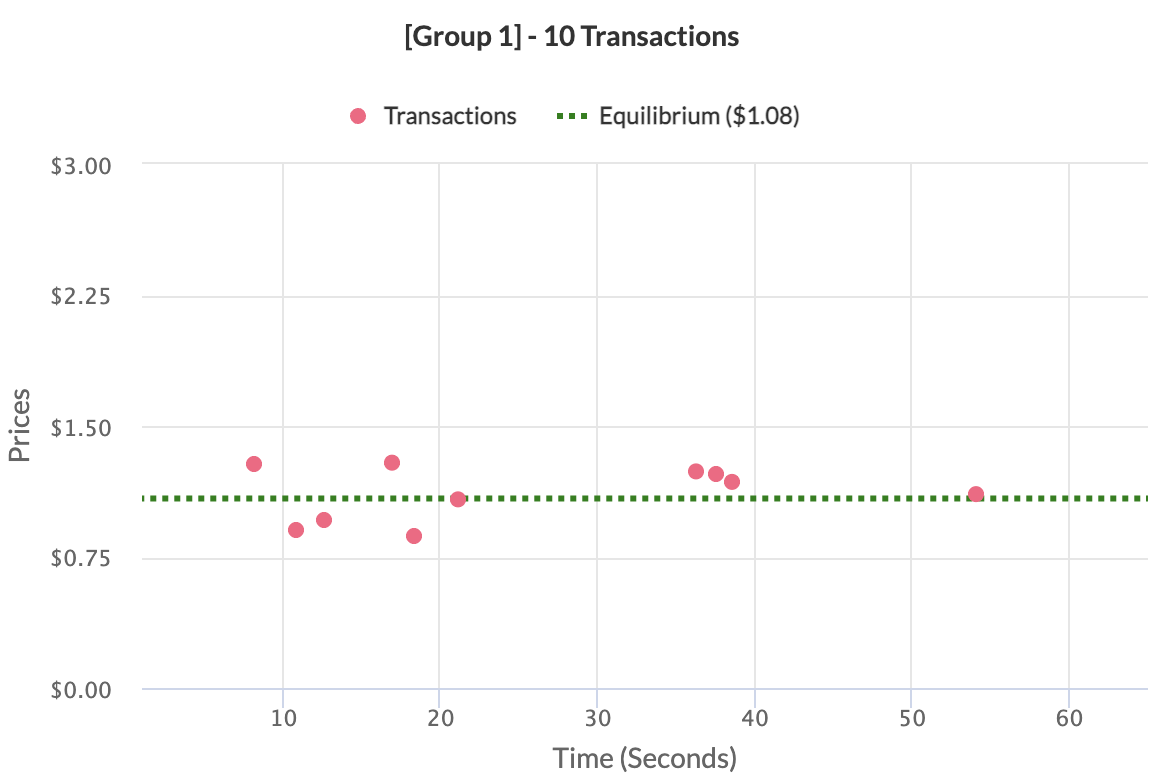Market for Oranges
MobLab’s Competitive Market game is one of our most popular games for teaching principles of microeconomics courses because it introduces students to supply, demand, and market equilibrium. Within the game, students are designated as either a buyer or a seller and act within a market based on the double auction for oranges. As they play through the game as traditionally self-interested buyers and sellers, students will begin to experience the market converging at the market equilibrium price.
But, once the game is over, then what? Students may still have questions:
From my experience as an economics teaching assistant (TA) for a principles course, I have worked closely with students and know that a simple introduction to a concept is never enough for students who want to dive deep into market theory. Holding a discussion with your class using the results from the market game is a great way to help students learn intuition behind the theory and discuss their actions as market actors.

Figure 1. Competitive Market Game Interface (Buyer)
Discussion of Competitive Market Game ResultsWhile there are many ways to engage your students in a meaningful discussion using the results of the competitive market game, such as a sequential presentation or through a narrative approach, I will walk through one way to kickstart the discussion, using frequent student pain points I have seen as a TA, and get students to think critically about the game they played and their actions as a buyer or seller.
During the supply and demand units of the class, I frequently noticed that students had many questions regarding how a supply and demand curve is built out. The conceptualization of what the line on the graph meant in real terms was difficult for some students to grasp. Pushing my students to think more critically about the consumer behavior behind a demand curve led them to make stronger connections with new subject matter as the unit introduced demand shifts, taxes, and price controls.
Now that I am an economist at MobLab, I have gained new perspectives on how to guide students to make conceptual connections using MobLab’s live results feature. To help students gain intuition on the mechanisms behind supply and demand, prompt them with questions to really get them thinking about what happened when they were selling or buying oranges. One way to foster this discussion about supply and demand is to discuss with your students what their strategies were as buyers and sellers and how these strategies changed as the game went on.
Once the game is over, share the results with your class but keep the data hidden by unchecking the demand, supply, transaction, and equilibrium buttons. With the blank screen shown to the class, discussion about the demand and supply curve can begin. First, identify those students in the class who had the role of buyer. Prompt the buyers to look at their end of game screen and raise their hand if they were able to buy oranges at a larger profit margin across rounds. This is a good check-in to see how the different strategies for buyers previously discussed compared in payoffs. Since the buyer’s value is decreasing across rounds, a majority of buyers will be raising their hands. Then reveal the market demand curve, which will be downward sloping, and explain the intuition behind decreasing marginal cost. Relating the concept to the student’s action really helps them grasp the concept of demand.
After this first round of discussion, turn to the students who played the role of supplier and ask a similar series of questions before revealing the market supply curve on the graph and explaining increasing marginal cost. Again, previous discussion of the suppliers’ strategy will be a good starting point before launching into an introduction of the market supply curve and why it is positively sloped.

Figure 2. Supply and Demand Graph
Now that students understand how to put themselves in the shoes of a supplier and buyer, it is time to address equilibrium! To introduce students to market equilibrium, using the data from the game, begin revealing the transactions within the game, showing the trend towards across the x-axis which represents time (Figure 3). At this point in the discussion, ask students why they think transactions occurred more rapidly towards the beginning of the game. This will engage students to think critically about equilibrium convergence. For most primary teaching goals, it will be crucial to show the transactions of the game converging to the equilibrium prediction. MobLab suggests focusing on price convergence since it is not uncommon to have one or two "missing" transactions.

Figure 3. Equilibrium Convergence
Finally, circle back to the discussion before the results were revealed and now ask the whole class if everyone was able to buy or sell all three oranges at a positive profit. In the competitive market game, only 87% of items demanded or supplied are sold at market equilibrium. This explains that even in market equilibrium, not everything gets sold and, therefore, equilibrium producer and consumer surplus are relatively equal. To dive deeper, go through both the buyer and seller groups and note the seller and buyer surplus to prove this.
MobLab’s Competitive Market game is one of our most popular games for teaching principles of microeconomics courses because it introduces students to supply, demand, and market equilibrium. Within the game, students are designated as either a buyer or a seller and act within a market based on the double auction for oranges. As they play through the game as traditionally self-interested buyers and sellers, students will begin to experience the market converging at the market equilibrium price.
But, once the game is over, then what? Students may still have questions:
- Where does the supply curve come from?
- Why does the demand curve slope downward?
- Why was I able to trade my first orange so quickly but then had more difficulty trading my third orange?
From my experience as an economics teaching assistant (TA) for a principles course, I have worked closely with students and know that a simple introduction to a concept is never enough for students who want to dive deep into market theory. Holding a discussion with your class using the results from the market game is a great way to help students learn intuition behind the theory and discuss their actions as market actors.

Figure 1. Competitive Market Game Interface (Buyer)
Discussion of Competitive Market Game Results
During the supply and demand units of the class, I frequently noticed that students had many questions regarding how a supply and demand curve is built out. The conceptualization of what the line on the graph meant in real terms was difficult for some students to grasp. Pushing my students to think more critically about the consumer behavior behind a demand curve led them to make stronger connections with new subject matter as the unit introduced demand shifts, taxes, and price controls.
Now that I am an economist at MobLab, I have gained new perspectives on how to guide students to make conceptual connections using MobLab’s live results feature. To help students gain intuition on the mechanisms behind supply and demand, prompt them with questions to really get them thinking about what happened when they were selling or buying oranges. One way to foster this discussion about supply and demand is to discuss with your students what their strategies were as buyers and sellers and how these strategies changed as the game went on.
Once the game is over, share the results with your class but keep the data hidden by unchecking the demand, supply, transaction, and equilibrium buttons. With the blank screen shown to the class, discussion about the demand and supply curve can begin. First, identify those students in the class who had the role of buyer. Prompt the buyers to look at their end of game screen and raise their hand if they were able to buy oranges at a larger profit margin across rounds. This is a good check-in to see how the different strategies for buyers previously discussed compared in payoffs. Since the buyer’s value is decreasing across rounds, a majority of buyers will be raising their hands. Then reveal the market demand curve, which will be downward sloping, and explain the intuition behind decreasing marginal cost. Relating the concept to the student’s action really helps them grasp the concept of demand.
After this first round of discussion, turn to the students who played the role of supplier and ask a similar series of questions before revealing the market supply curve on the graph and explaining increasing marginal cost. Again, previous discussion of the suppliers’ strategy will be a good starting point before launching into an introduction of the market supply curve and why it is positively sloped.

Figure 2. Supply and Demand Graph
Now that students understand how to put themselves in the shoes of a supplier and buyer, it is time to address equilibrium! To introduce students to market equilibrium, using the data from the game, begin revealing the transactions within the game, showing the trend towards across the x-axis which represents time (Figure 3). At this point in the discussion, ask students why they think transactions occurred more rapidly towards the beginning of the game. This will engage students to think critically about equilibrium convergence. For most primary teaching goals, it will be crucial to show the transactions of the game converging to the equilibrium prediction. MobLab suggests focusing on price convergence since it is not uncommon to have one or two "missing" transactions.

Figure 3. Equilibrium Convergence
Finally, circle back to the discussion before the results were revealed and now ask the whole class if everyone was able to buy or sell all three oranges at a positive profit. In the competitive market game, only 87% of items demanded or supplied are sold at market equilibrium. This explains that even in market equilibrium, not everything gets sold and, therefore, equilibrium producer and consumer surplus are relatively equal. To dive deeper, go through both the buyer and seller groups and note the seller and buyer surplus to prove this.
Conclusion
Using results to foster discussion means that a market for oranges can in fact help students understand the intuition behind supply, demand, and market equilibrium. Engage your students in a discussion about their behavior and how their actions reinforce fundamental economic concepts.
As a previous economics TA, I have seen students struggle time and time again with supply, demand, and equilibrium. Bringing students into the discussion and using their own results can help prevent pain points from arising and set students up for success for other concepts.
Games can be a great way to keep your students engaged in economic concepts, especially when coupled with a debrief of the results from the class. Want to learn more about bringing economics games into the classroom and breaking down results? Please contact our team for more information!

